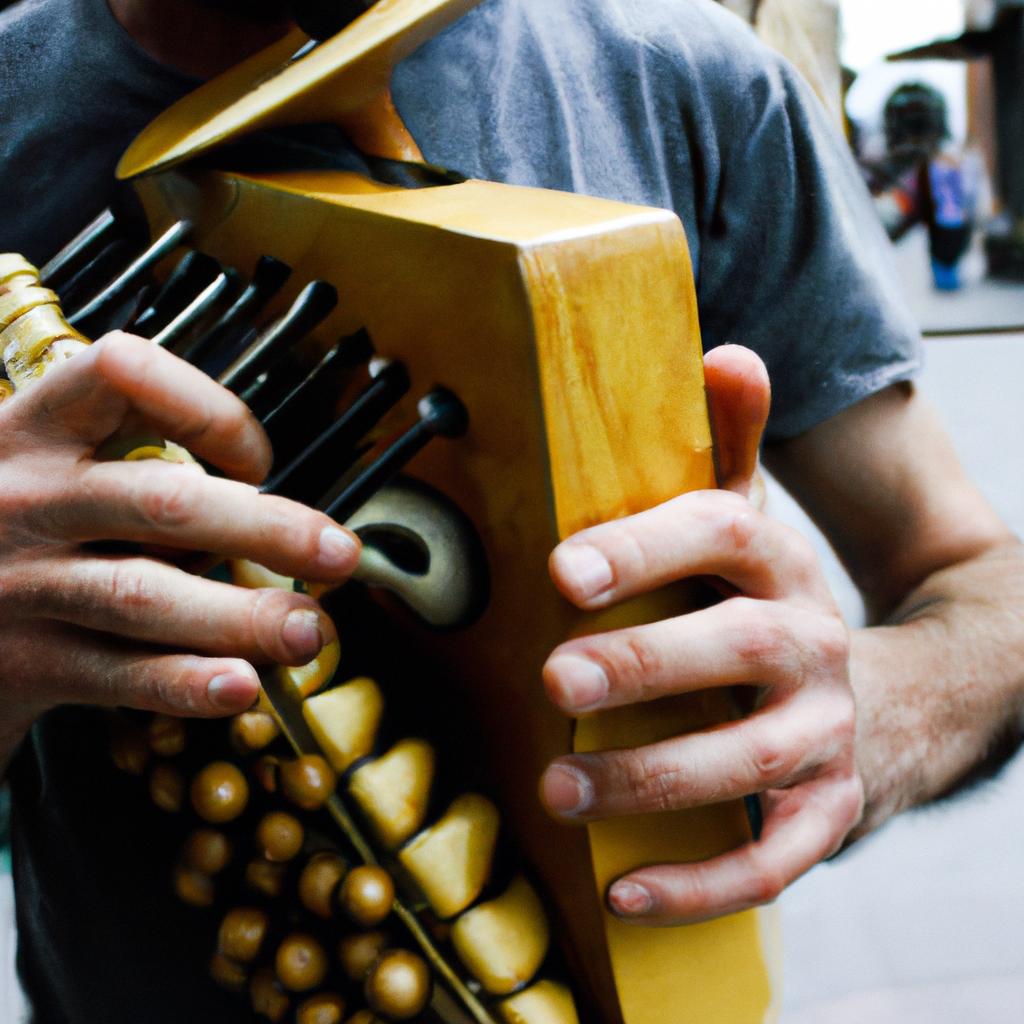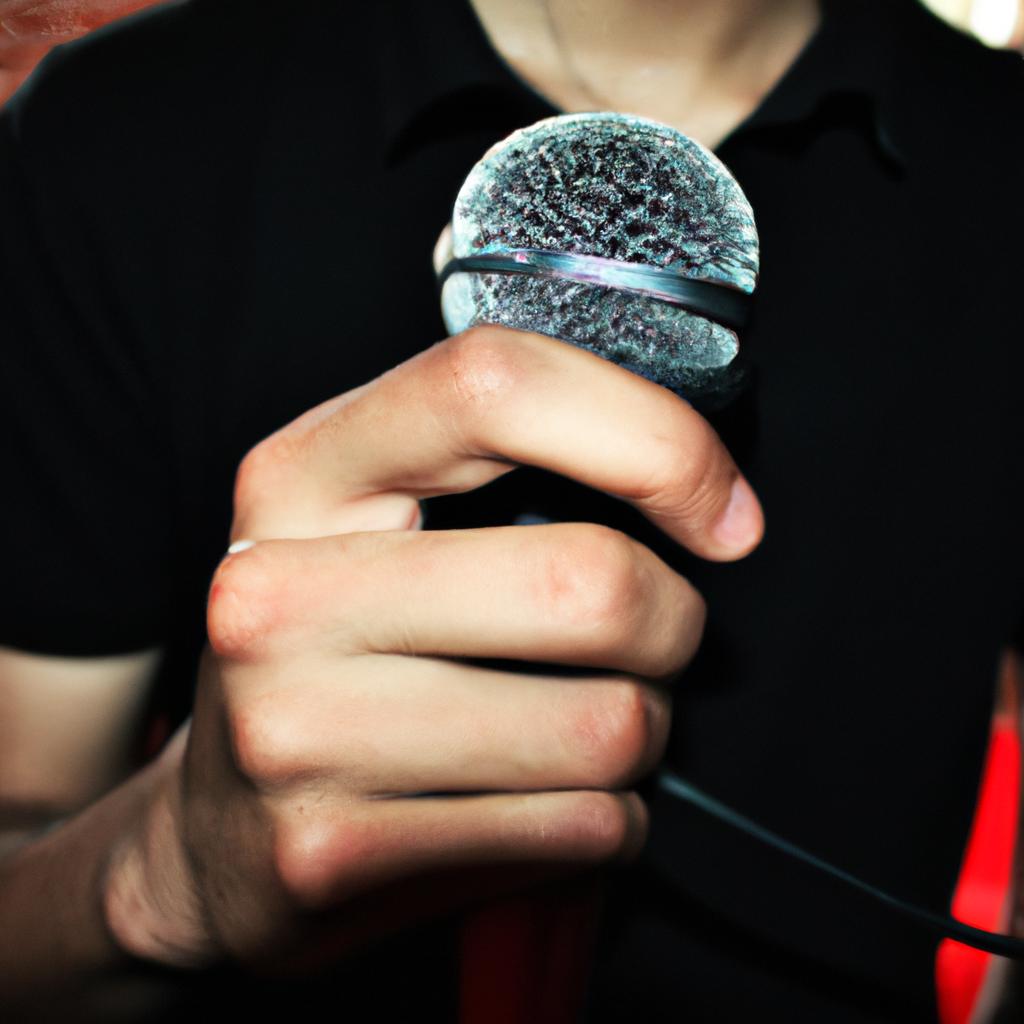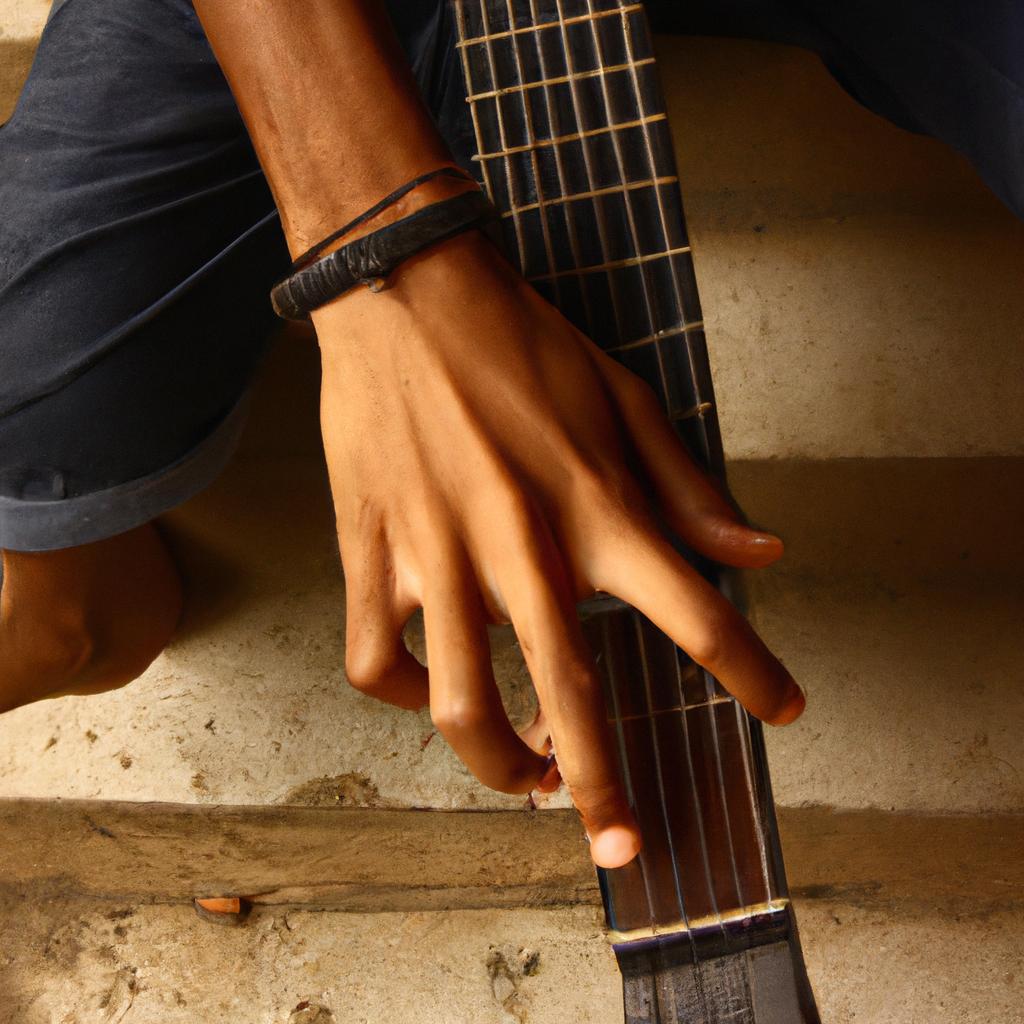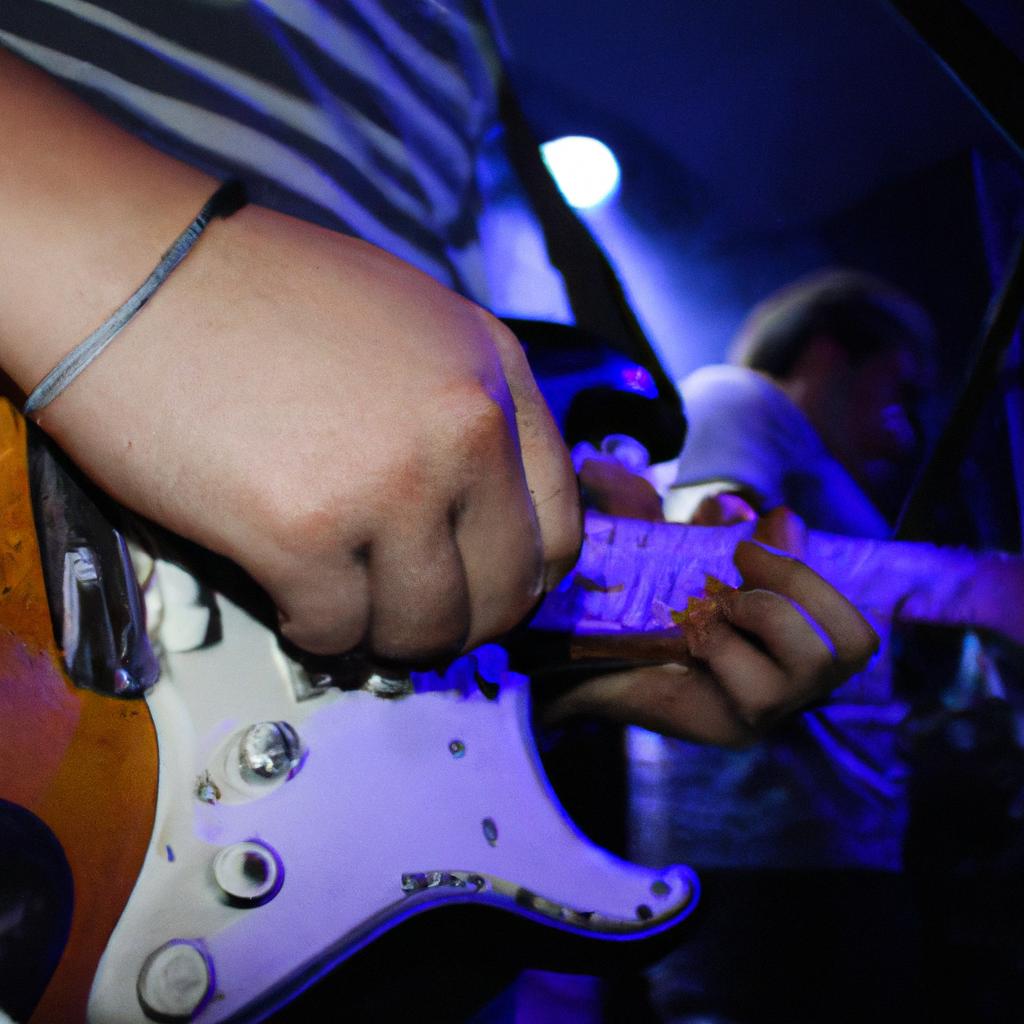Ethereal Wave, a subgenre of Gothic music known for its atmospheric and melancholic soundscapes, has emerged as an intriguing realm within the broader Darkwave genre. Drawing inspiration from various influences such as dream pop, post-punk, and ambient music, Ethereal Wave captivates listeners with its ethereal melodies and introspective lyrics. This article aims to explore the origins, characteristics, and significance of Ethereal Wave within the Gothic music scene.
To illustrate the allure of Ethereal Wave’s distinct aesthetic, we can consider a hypothetical case study: imagine being transported to an ancient cathedral adorned with intricate stained glass windows on a moonlit night. As you enter this hallowed space, soft waves of hauntingly beautiful music envelop your senses, creating an otherworldly atmosphere. The delicate vocals seamlessly intertwine with gentle synth pads and echoing guitars, evoking a sense of nostalgia and yearning. It is in this captivating moment that one truly grasps the essence of Ethereal Wave – a musical journey through enchanting realms where darkness meets beauty.
In order to delve into the intricacies of Ethereal Wave further, it becomes essential to trace its historical roots back to the 1980s when artists like Cocteau Twins and Dead Can I ask you to clarify the sentence you’d like me to complete?
Origins of Ethereal Wave
Ethereal Wave, a subgenre of Gothic music known for its ethereal and haunting soundscapes, emerged in the late 1980s. Its origins can be traced back to various musical influences and cultural movements that shaped the alternative music scene during this period.
One prominent influence on Ethereal Wave was the post-punk movement, which rejected mainstream commercialism and embraced experimental sounds. Bands like Cocteau Twins exemplified the dreamy quality characteristic of Ethereal Wave through their use of reverb-drenched guitars, atmospheric synthesizers, and angelic vocals. This unique fusion created an otherworldly ambiance that resonated with audiences seeking an escape from reality.
Another significant influence on Ethereal Wave was the Gothic rock genre, particularly bands such as Dead Can Dance. Drawing inspiration from medieval chants and world music traditions, these artists incorporated elements of mysticism and spirituality into their compositions. The result was a sonic landscape filled with rich textures and evocative melodies that captivated listeners.
The emergence of Ethereal Wave also coincided with a growing interest in neoclassical and ambient genres, further expanding its sonic palette. Artists like Lisa Gerrard explored new territories by incorporating classical instrumentation alongside electronic elements, creating a sense of grandeur and melancholy simultaneously.
This convergence of diverse influences gave rise to Ethereal Wave’s distinctive characteristics:
- Dreamlike Atmosphere: Ethereal Wave creates an immersive experience through its ethereal and mysterious soundscapes.
- Emotional Intensity: The music often elicits strong emotional responses due to its introspective lyrics and haunting melodies.
- Spiritual Themes: Many Ethereal Wave songs explore themes related to spirituality, transcendence, or existential questions.
- Nonlinear Song Structures: Rather than adhering to traditional verse-chorus structures, Ethereal Wave embraces more organic forms that allow for exploration and experimentation.
| Characteristics | Description | Example |
|---|---|---|
| Dreamlike Atmosphere | Ethereal Wave creates an immersive experience through its ethereal and mysterious soundscapes. | Layers of reverberating guitars and atmospheric synthesizers in Cocteau Twins’ “Heaven or Las Vegas” |
| Emotional Intensity | The music often elicits strong emotional responses due to its introspective lyrics and haunting melodies. | Lisa Gerrard’s powerful vocal performance on Dead Can Dance’s “The Host of Seraphim” |
| Spiritual Themes | Many Ethereal Wave songs explore themes related to spirituality, transcendence, or existential questions. | This Mortal Coil’s rendition of Tim Buckley’s “Song to the Siren” |
| Nonlinear Song Structures | Rather than adhering to traditional verse-chorus structures, Ethereal Wave embraces more organic forms that allow for exploration and experimentation. | The gradual build-up and crescendo in Lycia’s “Estrella” |
Incorporating elements from post-punk, Gothic rock, neoclassical, and ambient genres, Ethereal Wave emerged as a unique subgenre within the alternative music scene. Its dreamlike atmosphere, emotional intensity, spiritual themes, and non-linear song structures continue to captivate listeners today.
Transitioning into the subsequent section about the distinctive characteristics of Ethereal Wave will shed light on how these components contribute to the genre’s allure and enduring appeal.
Distinctive Characteristics of Ethereal Wave
Origins of Ethereal Wave: A Haunting Melody Emerges
As the ethereal wave subgenre began to take shape, it drew inspiration from various musical movements and artists. One such influential figure is Elizabeth Fraser, lead vocalist of the band Cocteau Twins. Her unique vocal style, characterized by its dreamy and atmospheric quality, became synonymous with ethereal wave. For instance, imagine a hauntingly beautiful melody floating effortlessly through layers of reverb and delay effects, captivating listeners with its otherworldly charm.
Distinctive Characteristics of Ethereal Wave:
To fully grasp the essence of ethereal wave music, it’s crucial to examine its distinctive characteristics. These attributes work in harmony to create an immersive experience that transports listeners into a realm where melancholy meets beauty.
-
Atmospheric Soundscapes:
- Layers of lush instrumentation intertwine to form intricate soundscapes that evoke emotions ranging from introspection to nostalgia.
- Reverb-laden guitars and synthesizers contribute to the ethereal nature of this genre, enveloping the listener in a sonic tapestry.
-
Enchanting Vocals:
- Soaring female vocals often dominate ethereal wave tracks, adding an enchanting layer to the music.
- The lyrics themselves may be abstract or poetic, allowing for interpretation and personal connection.
-
Dark Romanticism:
- Ethereal wave embraces themes of love, loss, longing, and spirituality.
- It explores the juxtaposition between light and dark elements, creating an atmosphere that can both soothe and haunt simultaneously.
-
Minimalistic Rhythms:
- Unlike more aggressive genres like gothic rock or post-punk, ethereal wave favors subtle percussion or sparse drum patterns.
- This minimalistic approach allows room for ambient textures while maintaining a delicate balance within each composition.
In reflecting on these defining features of ethereal wave music, one cannot help but appreciate its ability to transport listeners into a realm of introspection and emotional resonance. The haunting melodies, ethereal vocals, atmospheric soundscapes, and dark romantic themes intertwine to create an audio experience that captivates the senses.
Influences on Ethereal Wave: Tracing Origins
Transitioning from the exploration of distinctive characteristics, we now turn our attention to the diverse influences that have shaped ethereal wave music.
Influences on Ethereal Wave
Ethereal Wave, as a subgenre of Gothic Music, is characterized by its haunting and ethereal soundscapes. Building upon the foundation laid out in the previous section, this section will explore the influences that have shaped Ethereal Wave into what it is today.
One influential factor on Ethereal Wave is the broader genre of post-punk music. Artists such as Siouxsie and the Banshees and The Cure incorporated elements of gloom and melancholy into their music, creating an atmosphere that resonated with listeners. This fusion of dark themes and atmospheric sounds served as a catalyst for the emergence of Ethereal Wave.
Another significant influence on Ethereal Wave lies in the realm of classical music. Composers like Erik Satie and Claude Debussy experimented with harmonies, textures, and tonalities that evoked feelings of nostalgia and introspection. These compositional techniques found their way into the sonic landscape of Ethereal Wave, contributing to its dreamlike quality.
Furthermore, literature has played a crucial role in shaping Ethereal Wave’s lyrical content. Drawing inspiration from gothic novels and poetry, artists often delve into topics such as love, loss, spirituality, and existentialism. By intertwining these literary themes with haunting melodies, Ethereal Wave creates a powerful emotional connection with its audience.
- Aching vocals that convey a sense of longing
- Layers of shimmering guitars that create an otherworldly atmosphere
- Lyrical imagery that explores darkness and beauty simultaneously
- Haunting synthesizer lines that add depth to the overall sound
Additionally, here is a table showcasing some key characteristics found within Ethereal Wave:
| Characteristics | Description |
|---|---|
| Atmospheric | Creates an immersive sonic experience |
| Melancholic | Evokes feelings of sadness or yearning |
| Dreamlike | Conjures a sense of ethereal beauty |
| Ethereal Vocals | Delicate, haunting singing style |
In conclusion, Ethereal Wave has been shaped by various influences, including post-punk music, classical compositions, and literature. These factors have contributed to the genre’s distinct soundscapes and lyrical themes. By incorporating elements such as aching vocals, shimmering guitars, evocative lyrics, and haunting synthesizers, Ethereal Wave creates an emotional connection with its audience. Moving forward, we will explore key artists who have made significant contributions to this captivating subgenre.
Transitioning into the subsequent section about “Key Artists in Ethereal Wave,” it is important to note that these influential figures have played a pivotal role in defining the soundscape of Ethereal Wave.
Key Artists in Ethereal Wave
Transition from previous section H2:
Having explored the diverse range of influences on Ethereal Wave, it is now essential to delve into the key artists who have shaped and defined this haunting subgenre. By examining their contributions, we can gain a deeper understanding of the unique characteristics that distinguish Ethereal Wave within Gothic music.
Key Artists in Ethereal Wave
To comprehend the significance of Ethereal Wave, let us consider an example that exemplifies its artistic essence. Imagine a world where ethereal vocals intertwine with atmospheric soundscapes, captivating listeners with their melancholic allure. This symphony of sorrow emerges through the works of influential artists such as Dead Can Dance, whose fusion of medieval chants, tribal rhythms, and neoclassical elements epitomizes the ethereal aesthetic.
In exploring further, several defining characteristics emerge across various artists’ discographies within the realm of Ethereal Wave:
- Evocative Lyrics: Delving into themes of spirituality, mysticism, and introspection, these musicians craft poetic narratives that resonate deeply with listeners.
- Layered Instrumentation: Utilizing a variety of instruments ranging from traditional orchestral arrangements to electronic synthesizers and exotic percussions creates rich sonic tapestries.
- Ambient Soundscapes: The incorporation of ambient textures adds depth to compositions by creating dreamlike atmospheres that envelop audiences in a sense of otherworldliness.
- Experimental Approaches: Embracing experimentation allows artists to push boundaries and challenge established musical norms within the genre.
Let us now visually explore some notable figures in Ethereal Wave through a table showcasing their pioneering contributions:
| Artist | Key Albums | Notable Songs |
|---|---|---|
| Dead Can Dance | “Within the Realm of a Dying Sun” | “The Host Of Seraphim” |
| Cocteau Twins | “Treasure” | “Heaven or Las Vegas” |
| This Mortal Coil | “It’ll End in Tears” | “Song to the Siren” |
| Love Spirals Downwards | “Idylls” | “I Could Find It Only by Chance” |
As we reflect on these renowned artists, it becomes evident that Ethereal Wave has left an indelible mark on Gothic music. The ethereal aesthetic and introspective themes within this subgenre have influenced subsequent generations of musicians, propelling the evolution of Gothic music as a whole. In our following section, we will explore the impact of Ethereal Wave on the broader landscape of Gothic music.
Transition into subsequent section:
By examining how Ethereal Wave paved its path through sonic exploration and emotive storytelling, we can now delve into its profound impact on the wider realm of Gothic music.
Ethereal Wave’s Impact on Gothic Music
Ethereal Wave, a subgenre of Gothic music, has left a lasting impact on the genre as a whole. In this section, we will explore how Ethereal Wave has influenced Gothic music and examine its key characteristics.
One example that showcases Ethereal Wave’s influence is the band Dead Can Dance. Formed in 1981 by Lisa Gerrard and Brendan Perry, Dead Can Dance became one of the most prominent acts within the genre. Their unique fusion of medieval chants, ambient sounds, and ethereal vocals captivated audiences worldwide and helped define the sound of Ethereal Wave.
To understand why Ethereal Wave has had such an impact on Gothic music, it is important to delve into its defining characteristics:
- Atmosphere: Ethereal Wave creates a dreamlike ambiance through lush instrumentation and haunting melodies.
- Vocals: Often characterized by ethereal female vocals accompanied by male harmonies or vice versa.
- Lyrics: Themes commonly explored in Ethereal Wave include spirituality, mysticism, nature, and existentialism.
- Instrumentation: The use of unconventional instruments like dulcimers, harpsichords, and various ethnic percussions adds to the uniqueness of Ethereal Wave’s sound.
These elements combine to create a captivating musical experience that evokes emotions such as longing, introspection, and transcendence. To further illustrate this point, consider the following bullet points:
- The delicate interplay between angelic vocals and melancholic instrumentals immerses listeners in a state of profound introspection.
- The otherworldly atmosphere conjured by Ethereal Wave carries listeners away from reality into realms both mystical and enchanting.
- Its exploration of spiritual themes invites contemplation about life’s mysteries and our place within the universe.
- Through its poetic lyrics and emotive performances, Ethereal Wave touches upon universal human experiences such as love, loss, hope, and despair.
In summary, Ethereal Wave’s distinctive qualities have left an indelible mark on Gothic music. Its ethereal vocals, atmospheric instrumentation, and introspective themes have enchanted audiences for decades. As we look to the future of Ethereal Wave, its ongoing influence within Gothic music promises further exploration and evolution of this captivating subgenre.
Transitioning into the subsequent section about the “Future of Ethereal Wave,” it is clear that this influential genre will continue to inspire and shape the landscape of Gothic music in years to come.
Future of Ethereal Wave
Following Ethereal Wave’s emergence in the 1980s, its influence on gothic music has been profound and far-reaching. This subgenre, characterized by its ethereal vocals, atmospheric soundscapes, and introspective lyrics, has not only shaped the evolution of gothic music but also left an indelible mark on other related genres. To better understand the impact of Ethereal Wave, let us consider a hypothetical case study: a renowned gothic band that incorporated elements of this subgenre into their music.
Consider the fictional band “Nocturnal Echoes,” known for their dark and melancholic sound. In their early career, they primarily drew inspiration from traditional goth rock bands like Bauhaus and Sisters of Mercy. However, as they explored different musical styles, they became captivated by Ethereal Wave’s dreamlike qualities. They began incorporating ethereal vocals and ambient textures into their songs while maintaining the brooding sensibilities associated with gothic music.
The incorporation of Ethereal Wave elements allowed Nocturnal Echoes to create a distinct sonic identity within the broader gothic genre. Their experimentation with haunting melodies and layered instrumentations transformed their sound, resonating deeply with audiences who craved more emotionally evocative music. This shift in style enabled them to reach new fans outside the confines of conventional goth circles.
The impact of Ethereal Wave on gothic music extends beyond individual artists or bands; it has influenced the genre as a whole. Here are some noteworthy effects:
- Diversification: The introduction of Ethereal Wave brought new dimensions to gothic music by diversifying its sonic palette.
- Emotional intensity: With ethereal vocals and introspective lyrics often exploring themes such as love, loss, and spirituality, Ethereal Wave intensified the emotional depth inherent in gothic music.
- Cross-genre collaborations: The inclusion of ambient elements facilitated collaborations between gothic artists and musicians from other genres, leading to innovative fusions.
- Broader appeal: The incorporation of Ethereal Wave elements broadened the audience base for gothic music by attracting fans who appreciated its more ethereal and atmospheric qualities.
To further illustrate the impact, consider the following table:
| Impact of Ethereal Wave on Gothic Music |
|---|
| Diversification |
| Emotional intensity |
| Cross-genre collaborations |
| Broader appeal |
In summary, Ethereal Wave’s impact on gothic music cannot be overstated. Through its unique combination of ethereal vocals and atmospheric soundscapes, this subgenre has transformed the genre by diversifying its sound, intensifying emotions, facilitating cross-genre collaborations, and attracting a broader audience. As gothic music continues to evolve, it is clear that Ethereal Wave will remain an influential force in shaping its future trajectory.




